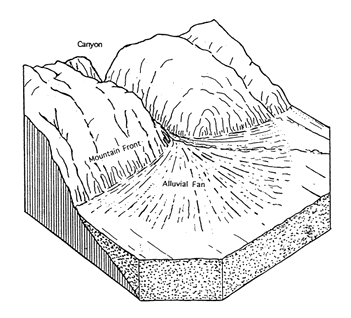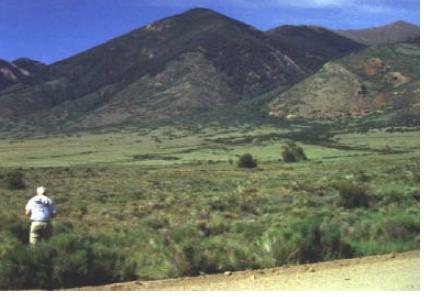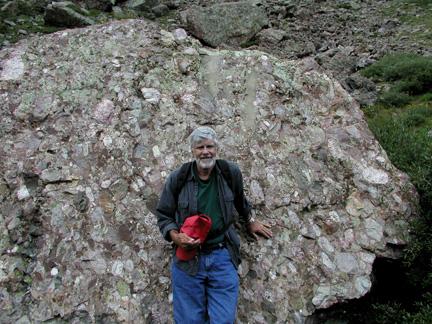Alluvial Deposits Abound in Rock Record of the Sangres |
|
Wayne I. Anderson |
||
"Show me someone who likes stream deposits and I'll show you an alluvial fan." That's a silly pun and perhaps only funny to a geologist. However, alluvial deposits are no laughing matter as far as the geological history of the Sangres is concerned. Alluvial fans are flat to gently-sloping masses of loose rock material (largely sand and gravel) that are shaped like an open fan. They form at the base of mountains where fast-flowing streams meet relatively-flat surfaces of basin floors or broad valleys. At this juncture, the gradients of streams abruptly decrease and gravel, sand, and other sediments are deposited. |
|
 |
||
Alluvial fans form where fast-flowing mountain streams meet the valley floors of basins such as the Wet Mountain and San Luis valleys. Because of reduced gradients of the streams at the base of the mountains, deposition of sediment occurs and alluvial fans are formed. Adapted from Strahler,1963, The Earth Sciences. |
||
Thick sequences of alluvial sediments, the products of coalescing alluvial fans, blanket the interface between the Sangres and the adjacent Wet Mountain Valley. Likewise, an apron of alluvial sediments carpets the west flank of the Sangres at their intersection with the San Luis Valley. There, displaced sediments in some alluvial fans on the west flank of the Sangres document that the bordering faults of the range were active as recently as 7,500 to 7,800 years ago. Detailed studies of the Sangre de Cristo Fault Zone, bordering the San Luis Valley and the west flank of the Sangres, document as many as 13 displacements of alluvial sediments during the last 400,000 years, with individual offsets of 5.2 to 7.2 feet. Alluvial sediments on the east side of the Sangres show no comparable offset, however. |
|
 |
||
Alluvial fans are common along both the east and west flanks of the Sangre de Cristo Range. Some alluvial fans at the interface of the San Luis Valley and the west flank of the Sangres were displaced five to seven feet by faulting as recently as 7,500 to 7,800 years ago. Geologist in lower left corner for scale. |
||
The Wet Mountain Valley, bordering the Sangres on the east, is floored by a thick sequence of valley-fill sediments. These sediments are largely the products of stream deposition during the past 50 million years. The upper 200 feet of these sediments commonly supply water to wells in Custer County. Logs of a few water wells provide information on valley-fill sediments that are 300 to 1,200 feet deep, but no rock or sediment record is available for the deeper part of the Wet Mountain Valley. However, geophysical studies suggest that more than 6,000 feet of sediments occur along the west side of the Wet Mountain Valley. These sediments are probably primarily of alluvial origin, and they likely have significant water-yielding potential. Strata that make up some of the highest peaks in the modern Sangres are ancient alluvial deposits. For example, the Crestone Conglomerate Member of the Sangre de Cristo Formation is prominent on Crestone Needle and in the adjacent high country. The conglomerates represent huge alluvial fans deposited along the flanks of the Ancestral Rocky Mountains, approximately 250 to 300 million years ago. The Crestone Conglomerate is one of the most distinctive rocks in the modern Sangres, and the size of its clasts are noteworthy. Rounded rocks as big as Rocky Ford cantaloupes are common in the conglomerate in the Crestone area and in the upper reaches of South Colony Creek. |
|
 |
||
A geologist stands next to a massive boulder of Crestone Conglomerate, near the head of Horn Creek drainage. Note the size of the clasts composing the conglomerate. The Crestone Conglomerate displays an impressive rock record of ancient alluvial-fan desposits. |
||
In summary, alluvial sediments and rocks are significant in the area's geological record in several ways. For example, alluvial fans contribute to the beauty of the modern landscape. In addition, valley-fill alluvium stores considerable quantities of groundwater and provides drinking water for hundreds of Wet Valley residents. Moreover, some of the highest peaks in the modern Sangres are underlain by coarse conglomerates, representing the sedimentary record of immense alluvial fans that formed over 250 million years ago. |
|
References Lindsey, D. A. , P. A. M. Andriessen, and B . R. Wardlaw. 1986. "Heating, Cooling, and Uplift during Tertiary Time, Northern Sangre de Cristo Range." Geological Society of America Bulletin 97: 1133-1143. McCalpin, J. P. 1987. "Recurrent Quaternary Normal Faulting at Major Creek, Colorado: An Example of Youthful Tectonism on the Eastern Boundary of the Rio Grande Rift Zone." Geological Society of America Centennial Field Guide- Rocky Mountain Section, p. 353-356. Geological Society of America, Boulder, Colorado. Zohdy, A.A., R. L. A. Hershey, P. A. Emery, and W. D. Stanley. 1971. Resistivity Sections, Upper Arkansas River Basin, Colorado. U. S. Geological Survey Open File Report 71-337. |
|
 |
 |
 |
||||